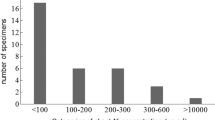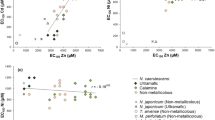Abstract
The polymorphism of arsenate tolerance in a Holcus lanatus L. population from an uncontaminated soil was investigated and a high percentage of tolerant individuals (65%) was found in the population studied. Influx of arsenate was highly correlated to arsenate tolerance within the population, with the most tolerant individuals having the lowest rates of arsenate influx. Isotherms for the high affinity arsenate uptake systems were determined in six tolerant and six non-tolerant genotypes. Tolerant plants had the lowest rates of arsenate influx. This was achieved by adaptation of the Vmax of arsenate influx with the Vmax of the high affinity uptake system saturating at lower substrate concentrations in the tolerant plants. The polymorphism is discussed with relation to adaptation to the extreme environments to which the plants are subjected on mine-spoil soils.
Similar content being viewed by others
References
Al-Hiyaly S A K, McNeilly T and Bradshaw A D 1990 The effect of zinc contamination from electricity pylons: Contrasting patterns of evolution in five grass species. New Phytol. 114, 183–190.
Atwell B J, Veerkamp M T, Stuiver B C E E and Kuiper P J C 1980 The uptake of phosphate by Carex species from oligotrophic to eutrophic swamp habitats. Physiol. Plant. 49, 487–494.
Baker A J M and Walker P L 1990 Ecophysiology of metal uptake by tolerant plants. In Heavy Metal Tolerance in Plants: Evolutionary Aspects. Ed. A J Shaw. pp 155–177. CRC Press, Boca Raton, FL.
Bieleski R L 1973 Phosphate pools, phosphate transport, and phosphate availability. Annu. Rev. Plant Physiol. 24, 225–252.
Bradshaw A D 1984 The importance of evolutionary ideas in ecology — and vice versa. Evolutionary Ecology Ed. B Shorrocks. pp 1–25. Blackwell Scientific Publications, Oxford.
Chapin F S 1980 The mineral nutrition of wild plants. Ann. Rev. Ecolog. Syst. 11, 233–260.
Colbourn P, Alloway B J and Thornton I 1975 Arsenic and heavy metals in soils associated with regional geochemical anomalies in South-West England. Sci. Total Environ. 4, 359–363.
Cook S A, Lefebvre C and McNeilly T 1972 Competition between metal tolerant and normal plant populations on normal soil. Evolution 26, 366–372.
Hommels C H, Saat T A W and Kuiper P J C 1990 Characterization of the high affinity K+ (Rb+) uptake system in roots of intact Taraxacum microspecies: Comparison of 12 microspecies in relation to the mineral ecology. New Phytol. 114, 695–701.
Macnair M R 1981 The uptake of copper by plants of Mimulus gutattus differing in genotype primarily at a single major copper tolerance locus. New Phytol. 88, 723–730.
Macnair M R 1990. The genetics of metal tolerance in natural populations. Heavy Metal Tolerances in Plants: Evolutionary Aspects Ed. A J Shaw. pp 235–253. CRC press, Boca Raton, Fl.
Macnair M R, Cumbes Q C and Meharg A A 1992 The genetics of arsenate tolerance in Yorkshire fog, Holcus lanatus L. Heredity (In press).
Macnair M R and Watkins A D 1983 The fitness of the copper tolerance gene of Mimulus gutattus in uncontaminated soil. New Phytol. 95, 133–137.
Marquardt D W 1963 An algorithm for least-squares estimation of nonlinear parameters. J. Soc. Ind. App. Math. 11, 431–441.
Meharg A A and Macnair M R 1990 An altered phosphate uptake system in arsenate tolerant Holcus lanatus. New Phytol. 16, 29–35.
Meharg A A and Macnair M R 1991a Uptake, accumulation and translocation of arsenate in arsenate tolerant and non-tolerant Holcus lanatus L. New Phytol. 117, 225–231.
Meharg A A and Macnair M R 1991b Mechanisms of arsenate tolerance in Deschampsia cespitosa L. (Beauv.) and Agrostis capillaris L.: Adaptation to the arsenate uptake system. New Phytol. 119, 291–297.
Meharg A A and Macnair M R 1992 Genetic correlation between arsenate tolerance and the rate of influx of aresenate and phosphate in Holcus lanatus L. Heredity (In press).
Nicholls M K and McNeilly T 1985 The performance of Agrostis capillaris L. genotypes, differing in copper tolerance, in rye grass swards on normal soil. New Phytol. 101, 207–217.
Paliouris G and Hutchinson T C 1991 Arsenic, cobalt and nickel tolerances in two populations of Silene vulgaris (Moench) Garcke from Ontario, Canada. New Phytol. 117, 449–459.
Porter E K and Peterson P J 1975 Arsenic accumulation by plants on mine waste (United Kingdom). Sci. Total Environ. 4, 365–371.
Porter E K and Peterson P J 1977 Arsenic tolerance in grasses growing on mine waste. Environ. Poll. 14, 255–265.
Silberbush M and Barber S A 1983 Sensitivity of simulated phosphorus uptake to parameters used by a mechanistic-mathematical model. Plant and Soil 74, 93–100.
Watkins A D and Macnair M R 1991 Genetics of arsenic tolerance in Agrostis capillaris L. Heredity 66, 47–54.
Wilson B J 1988 The cost of heavy-metal tolerance: An example. Evolution 42, 408–413.
Author information
Authors and Affiliations
Rights and permissions
About this article
Cite this article
Meharg, A.A., Macnair, M.R. Polymorphism and physiology of arsenate tolerance in Holcus lanatus L. from an uncontaminated site. Plant Soil 146, 219–225 (1992). https://doi.org/10.1007/BF00012015
Issue Date:
DOI: https://doi.org/10.1007/BF00012015




